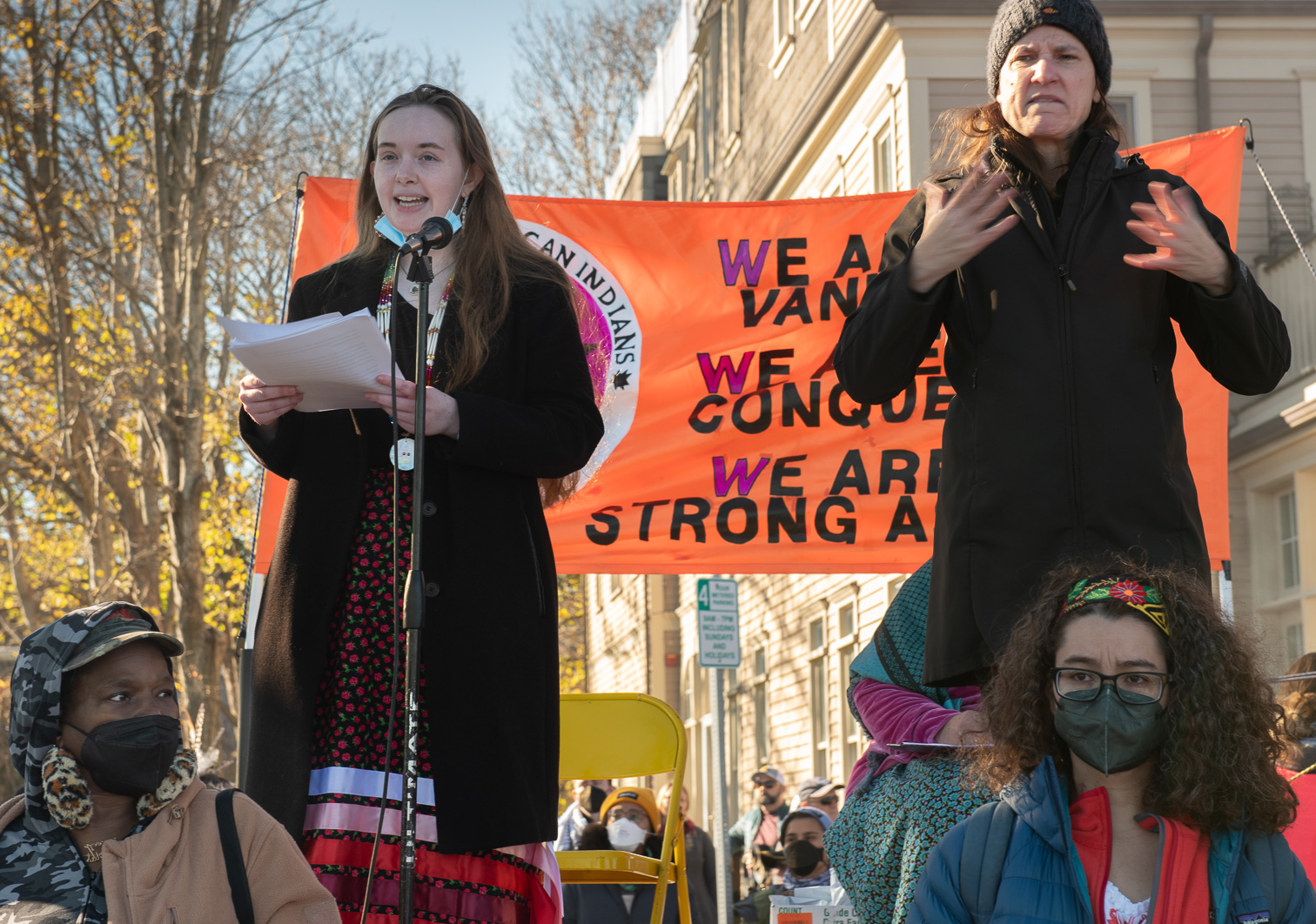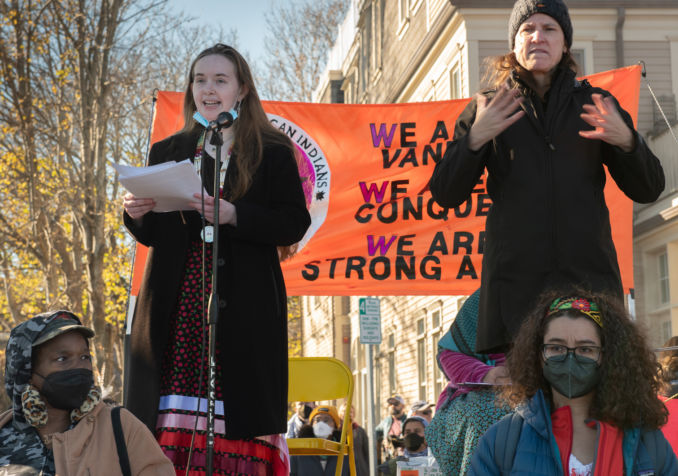

Kimimilasha James speaks at National Day of Mourning, Nov. 23, 2023. WW PHOTO: Rachel Duell
These slightly edited remarks were given by Kimimilasha James (Aquinnah Wampanoag), co-leader of the United American Indians of New England, on Cole’s Hill, at the 54th annual National Day of Mourning, Nov. 23, 2023.
Once again on so-called “Thanksgiving Day,” United American Indians of New England and our supporters are gathered on this hill to observe a National Day of Mourning for the Indigenous people murdered by settler colonialism and imperialism, from Turtle Island to Palestine. Today marks the 54th time we have gathered here to mourn our ancestors, tear down settler mythologies, and speak truth to power.


Kimimilasha James speaks at National Day of Mourning, Nov. 23, 2023. WW PHOTO: Rachel Duell
‘What do we have to be thankful for?’
The National Day of Mourning came into existence 53 “Thanksgivings” ago when my grandfather, an Aquinnah Wampanoag man named Wamsutta Frank James, was invited by the Commonwealth of Massachusetts to speak at a banquet celebrating the 350th anniversary of the arrival of the Pilgrims.
The organizers of the banquet no doubt imagined that Wamsutta would sing the praises of the American settler-colonial project and thank the Pilgrims for bringing “civilization” to these shores. However, the speech that Wamsutta wrote, which was based on historical fact rather than the sham version of history perpetuated in the Thanksgiving myth, was a far cry from complimentary.
In his speech, Wamsutta not only named atrocities committed by the Pilgrims, but also reflected upon the fate of the Wampanoag at the hands of the settler invaders. Wamsutta’s speech contained a powerful message of Native American pride.
“Our spirit refuses to die,” wrote Wamsutta. “Yesterday we walked the woodland paths and sandy trails. Today we must walk the macadam highways and roads.
We are uniting. … We stand tall and proud; and before too many moons pass, we’ll right the wrongs we have allowed to happen to us.”
When state officials saw an advance copy of Wamsutta’s speech, they refused to allow him to deliver it, saying that the speech was too “inflammatory.” They told him he could speak only if he were willing to offer false praise of the Pilgrims. The organizers even offered to write a speech for him, one which would better fit with their settler narrative. But Wamsutta refused to have words put into his mouth.
His suppressed speech was printed in newspapers across the country, and he and other local Native activists began to plan a protest. The flier for this protest, which was circulated nationwide, read: “What do we have to be thankful for? The United American Indians of New England has declared Thanksgiving Day to be a National Day of Mourning for Native Americans.”
On so-called Thanksgiving Day, 1970, Wamsutta and members of at least 25 tribes, as well as a sprinkling of non-Native allies, gathered here on this hill, and observed the first National Day of Mourning.
Attendees spoke out about the Pilgrim invasion and conditions in Indian Country, marched around Plymouth, boarded the Mayflower II, and even buried Plymouth Rock in sand!
One leader of the American Indian Movement would later say of the first National Day of Mourning that it “is a day American Indians won’t forget. We went to Plymouth for a purpose: to mourn, since the landing of the Pilgrims, the repression of the American Indian; and to indict the hypocrisy of a system which glorifies that repression.”
The founders of National Day of Mourning could not have foreseen that generations would continue to gather here, year after year, carrying on this tradition. Many of the elders who stood on this hill and organized that first National Day of Mourning are no longer with us, but we feel their spirits guiding us today.
So why do so many Native people object to the Thanksgiving myth? According to this myth, the Pilgrims, seeking religious freedom, landed on Plymouth Rock. The Indians welcomed them with open arms, and then conveniently faded into the background and everyone lived happily ever after. The end.
Here is the truth:
So why does any of this matter? It is simple: When people perpetuate the myth of Thanksgiving, they are not only erasing our genocide, but also celebrating it.
We did not simply fade into the background, as the Thanksgiving myth says. We have survived and flourished. We have persevered. The very fact that you are here is proof that we did not vanish.
Our very presence frees this land from the lies of the history books and the mythmakers. We will remember and honor all of our ancestors in the struggle who went before us. We will speak truth to power as we have been doing since the first National Day of Mourning in 1970.
‘We are now being heard’
That first National Day of Mourning in 1970 was a powerful demonstration of Native unity, and it has continued for all these years as a powerful demonstration of the unity of all people who speak truth to power.
Many of the conditions that prevailed in Indian Country in 1970 still prevail today. In 1970, our average life expectancy was just 44 years. Today, we continue to have the lowest life expectancy of any group in the U.S., and the death rate for Native women has increased 20 percent over the past 15 years. In 1970, our suicide and infant mortality rates were the highest in the country. This has not changed.
All of us are struggling under the oppression of a capitalist system which forces people to make a bitter choice between heating and eating. And we will continue to gather on this hill until we are free from this oppressive system; until corporations and the U.S. military stop polluting the earth and until we dismantle the brutal apparatus of mass incarceration.
We will not stop until the oppression of our LGBTQ siblings is a thing of the past. Until unhoused people have homes. Until human beings are no longer locked in cages at the U.S. border, despite the fact that NO ONE IS ILLEGAL ON STOLEN LAND. Until no person goes hungry or is left to die because they have little or no access to quality health care. Until insulin is free and until union busting is a thing of the past.
We will not stop until Palestine is free. Until the U.S. ends its colonial occupations of Puerto Rico and the sovereign Kingdom of Hawai’i. Until the U.S. ends its interventions in Haiti and repays the billions it stole from the Haitian people. Until the U.S. pays reparations to Black Americans and until Land Back for Native nations! Until then, the struggle will continue!
In 1970 we demanded an end to the Bureau of Indian Affairs. It is still a demand today. Native nations do not need federal oversight to govern ourselves or take care of our own lands.
As we did in 1970, we mourn the loss of millions of our ancestors and the devastation of the land, water and air. We condemn all acts of violence and terrorism perpetrated by all governments and against all innocent peoples worldwide. This includes the myriad crimes of the United States government.
Since the invasion of Christopher Columbus, Indigenous people have been terrorized by settler governments. From the colonial period to the 21st century, this has entailed torture, massacres, systematic military occupations, and the forced removals of Indigenous peoples from their ancestral homelands.
Let us not forget that this country was founded on the ideology of white supremacy, the widespread practice of African enslavement and a policy of genocide and land theft.
Let us not forget that under the pipelines, skyscrapers, mines and oil rigs lie the interred bones, sacred objects and villages of our Native ancestors.
Today, on liberated territory, we will correct the history of a country that continues to glorify murderers such as Columbus, that worships slave-owning presidents, such as George Washington and Thomas Jefferson, and even carves their faces into the sacred Black Hills of the Lakota.
In 1970, very few people would have given any thought to the fact that the Indigenous people of this hemisphere do not look upon the arrival of the European invaders as a reason to give thanks. Today, many thousands stand with us in spirit as we commemorate the 2023 National Day of Mourning.
As my grandfather said back in 1970, “We are now being heard; we are now being listened to. The important point is that … we still have the spirit, we still have the unique culture, we still have the will and, most important of all, the determination to remain as Indians. We are determined, and our presence here … is living testimony that this is only the beginning of the American Indian, particularly the Wampanoag, to regain the position in this country that is rightfully ours.”
In the spirit of Crazy Horse, in the spirit of Metacom, in the spirit of Geronimo; above all, to all people who fight and struggle for real justice: We are not vanishing. We are not conquered. We are as strong as ever.
Philadelphia On March 26, the Pennsylvania Supreme Court denied political prisoner Mumia Abu-Jamal permission to…
There are two important and overlapping holidays on April 22: Earth Day and Vladimir Lenin’s…
Twelve people were arrested April 9 for blocking traffic to Travis Air Force Base, a…
Secretary-General of Hezbollah Sheikh Naim Qassem delivered a speech on April 18, 2025. Resistance News…
Anakbayan Philadelphia held a rally on April 19 to demand the U.S. end its military…
Boston, April 20, 2025 The leadership of the Democratic Party nationally and especially in Massachusetts…